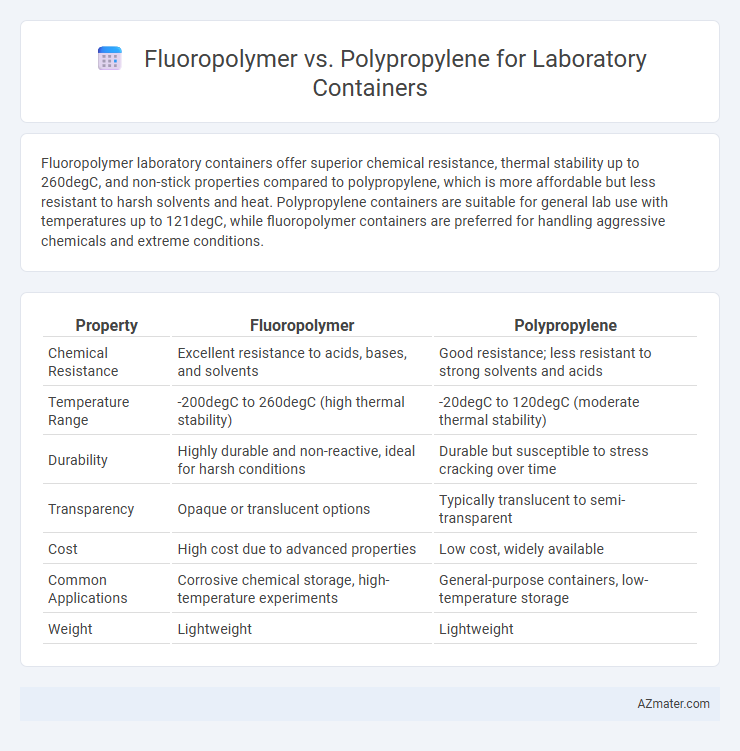Fluoropolymer laboratory containers offer superior chemical resistance, thermal stability up to 260degC, and non-stick properties compared to polypropylene, which is more affordable but less resistant to harsh solvents and heat. Polypropylene containers are suitable for general lab use with temperatures up to 121degC, while fluoropolymer containers are preferred for handling aggressive chemicals and extreme conditions.
Table of Comparison
| Property | Fluoropolymer | Polypropylene |
|---|---|---|
| Chemical Resistance | Excellent resistance to acids, bases, and solvents | Good resistance; less resistant to strong solvents and acids |
| Temperature Range | -200degC to 260degC (high thermal stability) | -20degC to 120degC (moderate thermal stability) |
| Durability | Highly durable and non-reactive, ideal for harsh conditions | Durable but susceptible to stress cracking over time |
| Transparency | Opaque or translucent options | Typically translucent to semi-transparent |
| Cost | High cost due to advanced properties | Low cost, widely available |
| Common Applications | Corrosive chemical storage, high-temperature experiments | General-purpose containers, low-temperature storage |
| Weight | Lightweight | Lightweight |
Introduction to Laboratory Container Materials
Fluoropolymer and polypropylene are common materials used for laboratory containers, each offering distinct chemical resistance and durability. Fluoropolymers, such as PTFE and FEP, provide superior resistance to aggressive chemicals, high temperatures, and maintain inertness in sensitive reactions. Polypropylene is valued for its cost-effectiveness, impact resistance, and broad chemical compatibility, making it suitable for general-purpose lab containers.
Overview of Fluoropolymers
Fluoropolymers are high-performance polymers characterized by exceptional chemical resistance, low surface energy, and thermal stability, making them ideal for laboratory containers exposed to aggressive chemicals and extreme temperatures. Their non-stick properties and ability to maintain integrity in harsh environments surpass common plastics like polypropylene, which is less resistant to solvents and heat. Fluoropolymers such as PTFE offer superior durability and minimal contamination risk, ensuring safer and more reliable storage and handling of laboratory reagents.
Overview of Polypropylene
Polypropylene is a widely used polymer in laboratory containers due to its chemical resistance, durability, and affordability. It offers excellent resistance to acids, bases, and solvents, making it suitable for a variety of laboratory applications. Although polypropylene has a lower temperature tolerance compared to fluoropolymers, its impact resistance and lightweight nature make it ideal for routine lab use.
Chemical Resistance Comparison
Fluoropolymer containers exhibit superior chemical resistance compared to polypropylene, effectively withstanding strong acids, bases, and organic solvents without degradation. Polypropylene is resistant to many chemicals but can swell, crack, or degrade when exposed to harsh solvents like aromatic hydrocarbons or strong oxidizers. For laboratory applications requiring long-term exposure to aggressive chemicals, fluoropolymer materials provide a more durable and reliable containment solution.
Temperature Tolerance and Stability
Fluoropolymer laboratory containers exhibit superior temperature tolerance, withstanding extreme conditions from -200degC to 260degC while maintaining chemical stability and resistance to corrosive substances. Polypropylene containers typically endure temperatures between -20degC and 120degC, making them less suitable for high-temperature or harsh chemical environments. The enhanced thermal stability and inertness of fluoropolymers ensure extended durability and reliable performance in demanding laboratory applications.
Durability and Longevity
Fluoropolymer laboratory containers exhibit superior chemical resistance and thermal stability, ensuring exceptional durability even under aggressive solvents and extreme temperatures. Polypropylene containers, while cost-effective and resistant to many chemicals, have lower thermal resistance and may degrade faster with prolonged exposure to harsh substances. Fluoropolymers' molecular structure lends to a longer service life, making them ideal for applications requiring high durability and extended longevity in laboratory environments.
Cost Implications and Budget Considerations
Fluoropolymer laboratory containers offer superior chemical resistance and durability but come with significantly higher costs compared to polypropylene, impacting budget allocation for research facilities. Polypropylene containers provide a cost-effective alternative with adequate chemical resistance for many applications, making them suitable for laboratories with limited budgets or less demanding chemical storage needs. Decision-makers must weigh the initial investment in fluoropolymer against the frequency of container replacement and specific chemical compatibility requirements to optimize overall expenditure.
Applications in Laboratory Settings
Fluoropolymer laboratory containers offer superior chemical resistance and thermal stability for handling aggressive solvents and high-temperature reactions, making them ideal for pharmaceutical and chemical analysis. Polypropylene containers provide cost-effective, lightweight storage solutions with good resistance to acids, bases, and aqueous solutions, suitable for sample storage and routine laboratory use. Selection between fluoropolymer and polypropylene depends on the specific chemical compatibility and temperature requirements in laboratory settings.
Environmental Impact and Sustainability
Fluoropolymer laboratory containers offer exceptional chemical resistance and durability but present environmental challenges due to their persistence and difficulty in recycling. Polypropylene containers, while less chemically resistant, are more widely recyclable and biodegrade more readily under industrial composting conditions. Choosing polypropylene enhances sustainability efforts by reducing long-term environmental pollution and supporting circular economy practices in laboratory settings.
Choosing the Right Material for Your Laboratory
Fluoropolymer laboratory containers offer exceptional chemical resistance, high-temperature tolerance, and non-reactive surfaces, making them ideal for handling aggressive solvents and acids in demanding experiments. Polypropylene containers provide cost-effective, durable, and lightweight options with good resistance to many chemicals but have lower temperature limits and can degrade with stronger solvents. Selecting the right material depends on your laboratory's chemical exposure, temperature requirements, and budget constraints to ensure safety and experiment integrity.

Infographic: Fluoropolymer vs Polypropylene for Laboratory Container
 azmater.com
azmater.com